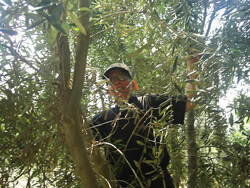The Electronic Intifada 15 October 2008

An ISM volunteer picks olives in the Gaza Strip. (Rami Almeghari)
According a group of Beit Hanoun residents promoting voluntary agricultural work, at least three attacks have been reported over the past four months, the most serious of which was when Israeli soldiers fired on farmers working in a field, about 600 meters away from the border.
The agricultural town in northern Gaza is the point in Gaza closest to Israel. The town has been repeatedly attacked by the Israeli army over the past eight years, and nearly two years ago 19 Palestinians were killed and 40 wounded when Israeli forces shelled a row of homes there.
Four months ago, Israel erected what it called a “buffer zone” of 300 meters along the Gaza-Israel eastern border. The Israelis claim that this zone was created to keep homemade rocket launchers away from the Israeli border.
“My presence here gives limited protection,” said 57-year-old American ISM volunteer Darlene Wallch while she picked olives.
Wallach added, “I don’t understand how come a bulldozer destroys trees, beautiful trees, whether they are olives or any other crops. … How come an Israeli bulldozer destroys trees or homes?”
A Greek volunteer participating in the harvest explained, “I am helping the Palestinians in their nonviolent resistance against the Israeli occupation. We show the Israelis that they cannot intimidate the Palestinian people, for the Palestinian people are not alone.”
The coordinator of the ISM in Gaza, Palestinian Fida Qishta explained that the ISM volunteers were part of the Free Gaza Movement action which broke the Gaza siege by boat on 23 August. Qishta said that these activists chose to remain in Gaza as part of the ISM, in solidarity with the besieged people of Gaza.
Qishta added that the ISM is looking forward to increasing the number of its Gaza members soon.
“We started with [supporting] the fishermen one month ago,” Qishta explained. Gaza’s fishermen are constantly harassed and fired upon by Israeli military forces, and are only allowed to fish very close to Gaza’s coast, severely restricting their catch and thus their income.
“We are currently supporting the farmers on the buffer zone, created by the Israelis in June of this year,” Qishta added.
On the usefulness of the international solidarity presence, Qishta said, “I think it’s effective because the people do not know the facts. I talked to the farmers, and they told us the reality that they are exposed to Israeli army fire on an almost daily basis. Therefore the ISM presence can send out a real message of the reality on the ground to the outside world.”
Earlier in the week, five members of the ISM went to the border wall with Israel in northern Gaza, where they tried to give some protection to the farmers there. Saber al-Zaneen, a farmer and organizer of the Beit Hanoun agricultural volunteers, recalled, “Darlene [Wallach] shouted at two military jeeps there, ‘We are here on Palestinian land, leave us alone. It’s not your right to keep us away from Palestinian land.’”
Al-Zaneen said it was the first time for him to approach to the border with Israel as Israeli forces shoot at any moving object there. But with the presence of the ISM, he and other Gazans managed to stand up on their own farm lands without fear.
Rami Almeghari is contributor to The Electronic Intifada, IMEMC.org and Free Speech Radio News. Rami is also a former senior English translator at and editor-in-chief of the international press center of the Gaza-based Palestinian Information Service. He can be contacted at rami_almeghari A T hotmail D O T com.
Related Links
- Israel declares Gaza “enemy entity” (19 September 2007)
- Harvesting with hope in Gaza, PHCR (11 September 2008)
- “I still cannot farm my own land”, PCHR (28 August 2008)
- Strawberry and cut flower farmers suffer under siege, PCHR (12 August 2008)
- Gaza flower producers watch their industry die, PCHR (27 February 2008)





